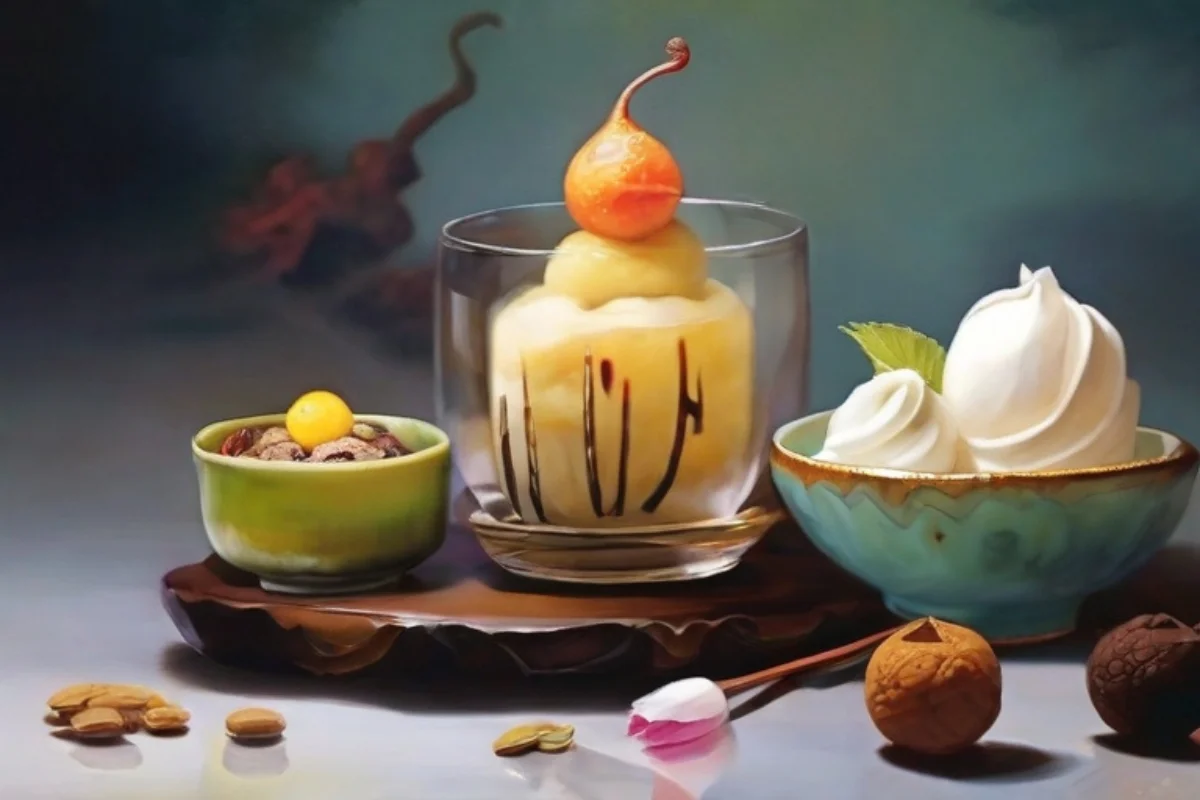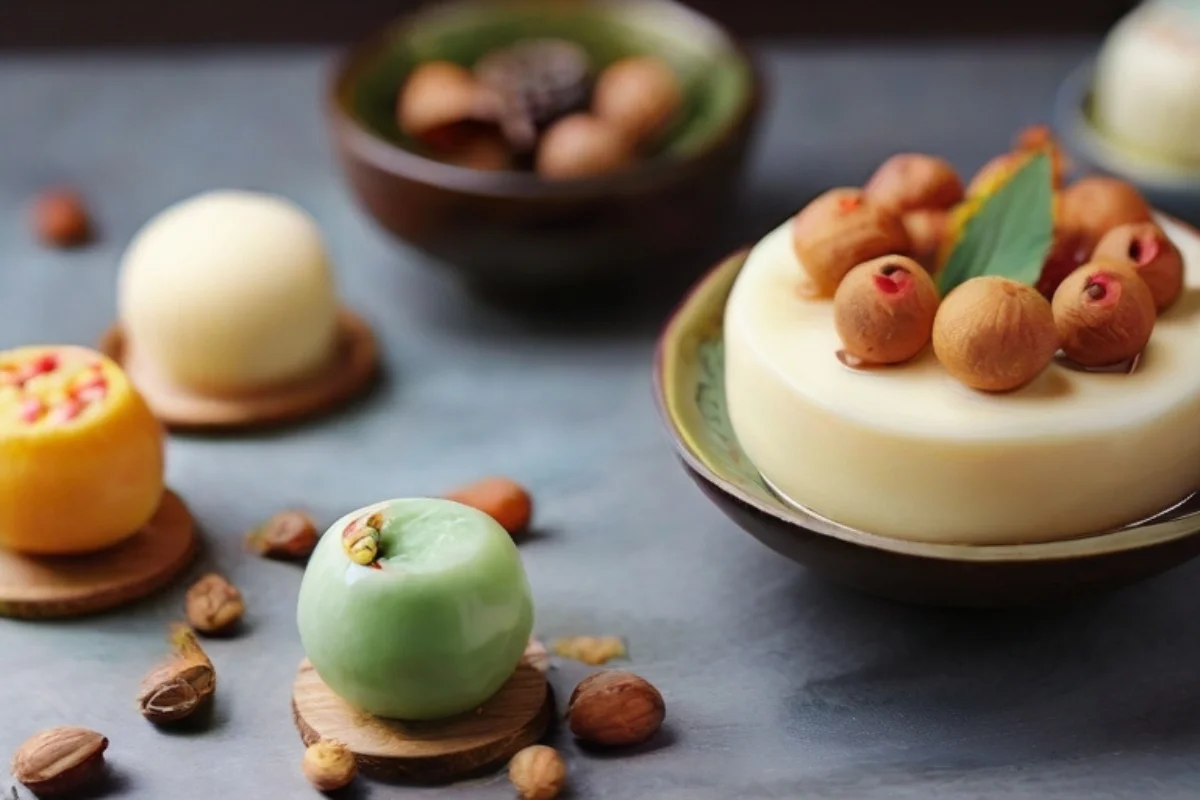The Sweet Spectrum of Asia
Asia offers a palette of flavors that goes beyond the conventional. The array of Asian desserts is a feast for both palate and eyes. They showcase colors, textures, and ingredients that reflect the continent’s cultural diversity.
The Japanese Delicacy: Mochi
Let’s start with Japan’s Mochi, a soft, sticky rice cake. Often, it wraps around a sweet filling of anko (red bean paste). This dessert is a marvel of simplicity and taste. It embodies the Japanese aesthetic of wabi-sabi, the beauty of imperfection. Mochi’s chewy texture and subtle sweetness have made it a global favorite. It serves as a gentle introduction to Asian sweets.
India’s Fragrant Finale: Gulab Jamun
In South Asia, India’s Gulab Jamun stands out. These golden, fried milk-solid balls are soaked in a syrup of rose water and cardamom. They offer a symphony of tastes that melt in the mouth, symbolizing Indian festivities.
The Filipino Fusion: Halo-Halo
The Philippines brings us Halo-Halo, a medley of shaved ice, evaporated milk, and various ingredients. From sweet beans to tropical fruits, this dessert reflects the Filipino spirit of innovation. It combines indigenous and borrowed elements to create a refreshing treat.
The Chinese Tradition: Mooncakes
In China, mooncakes shine during the Mid-Autumn Festival. These dense cakes, with sweet bean or lotus seed paste, symbolize reunion. Their ornate designs showcase the cultural significance of Asian desserts.
Korea’s Sweet Comfort: Bingsu
Korea offers Bingsu, a mountain of shaved ice with toppings ranging from sweet red beans to fresh fruit. Once a royal luxury, Bingsu has become a beloved summer treat. It reflects Korea’s love for communal dining.
A Taste of Tradition and Innovation
In our continued exploration of Asian desserts, we delve deeper into the confluence of tradition and modernity that shapes these sweet treats. The evolution of these desserts mirrors the dynamism of Asian cultures, blending time-honored techniques with contemporary twists.
Southeast Asian Gems: Thai Mango Sticky Rice
Venturing into Southeast Asia, Thailand’s Mango Sticky Rice stands as a beloved classic. This dessert pairs the natural sweetness of ripe mangoes with the creamy, glutinous texture of coconut milk-soaked sticky rice. A sprinkle of toasted sesame seeds or mung beans adds a subtle crunch, creating a harmonious blend of flavors and textures. It’s a testament to the Thai people’s mastery of balancing sweet, salty, and creamy elements.
Vietnamese Coffee Dessert: Ca Phe Trung
Vietnam introduces Ca Phe Trung, a unique coffee dessert that combines the rich, bold flavors of Vietnamese coffee with the creamy sweetness of whipped egg yolks and condensed milk. This concoction offers a caffeinated kick with a velvety smooth texture, showcasing Vietnam’s innovative spirit in reimagining traditional coffee into a dessert.
Modern Twists: Fusion Desserts
As Asia strides into the future, its desserts also undergo transformation. Fusion desserts, which blend elements from different Asian cuisines or incorporate Western techniques and ingredients, are gaining popularity. For instance, Matcha Tiramisu marries the earthy depth of Japanese matcha with the light, creamy texture of Italian tiramisu, creating a dessert that’s both familiar and entirely new.

The Rise of Dessert Cafes
Across Asia, dessert cafes have become hotspots for locals and tourists alike, eager to sample contemporary interpretations of traditional sweets. These cafes not only serve as culinary laboratories for innovative dessert creations but also as spaces where tradition meets trendy, allowing patrons to savor the past while enjoying the comforts of the present.
The Cultural Tapestry of Asian Desserts
As we venture further into the intricate world of Asian desserts, it becomes evident that these sweet treats are much more than mere indulgences. They are woven into the fabric of Asia’s social and cultural life, playing pivotal roles in festivals, celebrations, and everyday moments of joy.
Festive Favorites: Lunar New Year Sweets
In many Asian cultures, the Lunar New Year is a time of joyous celebration, and desserts play a crucial role in the festivities. For instance, the Chinese Nian Gao, a sticky rice cake, symbolizes prosperity and growth for the coming year. Similarly, in Vietnam, Banh Chung and Banh Tet, made from glutinous rice, mung beans, and pork, are traditional staples that honor the ancestors and bring the family together in celebration.
Wedding Sweets: Symbolizing Happiness and Unity
At Asian weddings, desserts are often imbued with symbolic meanings. In India, for instance, Laddu and Jalebi are distributed to guests to spread happiness and sweetness, reflecting the joyous union. In Japan, Wagashi served at weddings are meticulously crafted to represent good fortune, health, and longevity for the newlyweds.
Mooncake: A Mid-Autumn Delicacy
The Mid-Autumn Festival, celebrated across East and Southeast Asia, is synonymous with mooncakes. These intricately designed cakes are not just a treat; they’re a symbol of reunion and harmony, reflecting the full moon’s roundness. Families and friends gift mooncakes to each other as a gesture of goodwill and affection, reinforcing social bonds.
Everyday Delights: Bringing People Together
Beyond the festive occasions, Asian desserts are a part of daily life, serving as a medium for social interaction and kinship. Whether it’s sharing a bowl of Halo-Halo in the Philippines on a hot day or enjoying Kakigori with friends in Japan, these sweet moments are integral to fostering community ties and creating memories.

